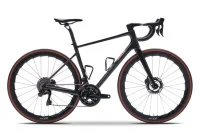Compact Cranks
A version![]() of this article was originally
of this article was originally
published in Triathlete Magazine
For some of the courses I race (like Ironman Lake Placid), I’ve felt that lower gearing would be helpful. I was thinking about a triple crank, but I’ve heard that compact cranks might be an even better option. Outside of lower gears, what else can I expect to experience if I go compact and will I need any other parts besides the crank to make the switch?
Sandra
Via E-mail
Dear Sandra,
While not offering gearing that is quite as low as a triple chainring crank, compact cranks offer lower gearing options than traditional double cranks while usually being significantly less expensive, lighter, and less mechanically complex than changing to a triple.
Before switching to compact, you should understand what you will give up and what you will gain in regards to gearing. While most traditional double cranks have a 53 tooth big chainring and a 39 tooth small chainring, most compact cranks come with a lower 50 tooth outer ring and 34 tooth inner ring. Unless there are rear cassettes available that offer a higher gear than what you are currently using (an 11-23 instead of a 12-23, for example), expect to sacrifice your highest (fastest) gear in exchange for the lower compact gearing. For those wanting to maintain as high a top gear as possible with compact, we have successfully set-up systems with aftermarket 52/36 chainrings.
In addition to changes in gearing, compact cranks change your bike mechanically. From a parts perspective, changing to compact can involve changing out as little as the crank itself. However, this is not always the case. Other potential mechanical changes to be aware of before switching to compact gearing are outlined below.
Gearing Jumps – The tooth difference between chainrings on a standard double crank is usually 14 teeth or less. For example, a 53 tooth outer chainring paired with a 39 tooth inner has a 14 tooth difference. Most compact cranks come from the factory with a 34 tooth inner ring and a 50 tooth outer ring – a 16 tooth jump. The larger the jump between rings, the less consistent shifting can be and the more likely the chain will rub the derailleur in more gears. If you are experiencing shifting or rub issues with compact gearing, changing the inner ring to a 36 tooth to bring the tooth difference to 14 can help.
Chain Length – Smaller chainrings need less chain and a link or two of chain should usually be removed when switching to compact to keep the chain taut and quiet in most gear combinations.
Front Derailleur – Front derailleurs are notoriously finicky devices regardless of gearing. While Shimano says that their standard front derailleurs work fine with compact cranks (and they usually do), there are situations where the results are not as consistent as desired. To address this, FSA has recently released a compact specific derailleur design that is Shimano compatible and Campagnolo has been making compact specific derailleurs for their systems for over a year now.
Crank/Bottom Bracket Selection – Stiffer cranks and chainrings are almost always the most precise shifting – and the importance of stiffness to shift quality is magnified on compact designs. Use cranks, chainrings and bottom brackets that are as stiff as possible for best results. Campagnolo’s carbon compact cranks and chainrings are stiffer than average, while external bearing crank designs (like Shimano’s compact R770 crank, Truvativ’s Giga X Pipe and FSA’s Mega EXO systems) are some of the stiffer compact cranks on the market.
Over Shifting and Chain Suck – Outside of rub, the most common shifting issues we have seen with compact crank designs is a greater tendency for the chain to over shift and the chain getting sucked against the frame more frequently. While proper set-up and maintenance is paramount to minimizing the likelihood of these events occurring, even a well set up bike can be prone to throwing the chain and chain suck. For riders that are prone to these issues, there are inexpensive devices like the 3rd Eye ChainWatcher and anti-chain suck plates that can be installed on the frame to keep the chain cooperative. These chain watchers are not always compatible with aero tubing or non-traditional designs, so check with a well informed mechanic to find out what will work for you.
Wear and Tear – Just as 10 speed parts use less metal than 9 speed parts, compact chainrings are smaller, and thus wear quicker, than a traditional set up. Expect to replace chainrings more often on a compact system and be sure to keep your drivetrain clean and well lubricated.
650c Issues – In a given gear combination, 650c bikes are already geared lower than 700c, so many riders may not need compact on 650c. However, for those that are looking for a lower gear on their 650c bikes, be aware that the shorter and tighter rear frame triangles on many 650c frames can sometimes prove more problematic than their 700c counterparts. We have successfully installed compact systems on 650c bikes, but some have proven finicky. For this reason, all the items discussed above become even more important on 650c bikes.
Shifting Technique – A smooth and consistent pedal stroke and shifting technique can go a long way towards allowing a bike to shift smoothly while lowering the likelihood of a thrown chain. This is even more important with a compact crank. When shifting, plan ahead, shift early, “soft pedal” (back off on the intensity of your power) and focus on pedaling smooth circles at a moderate cadence for best results.
Compact cranks are an excellent option for those who want lower gearing than traditional double gearing offers without the added complexity of a triple crank. When selecting a compact system, focus on the compatibility of the system with your other components and focus on systems that maximize crank, bottom bracket and chainring stiffness for the most consistent results.
Good luck climbing out of Lake Placid next year and remember that having gears that are a little bit lower than you expect to use is a safer approach than running out of options at an inopportune time.
Good luck,
Ian
Originally published November 2005/Copyright © 2005









